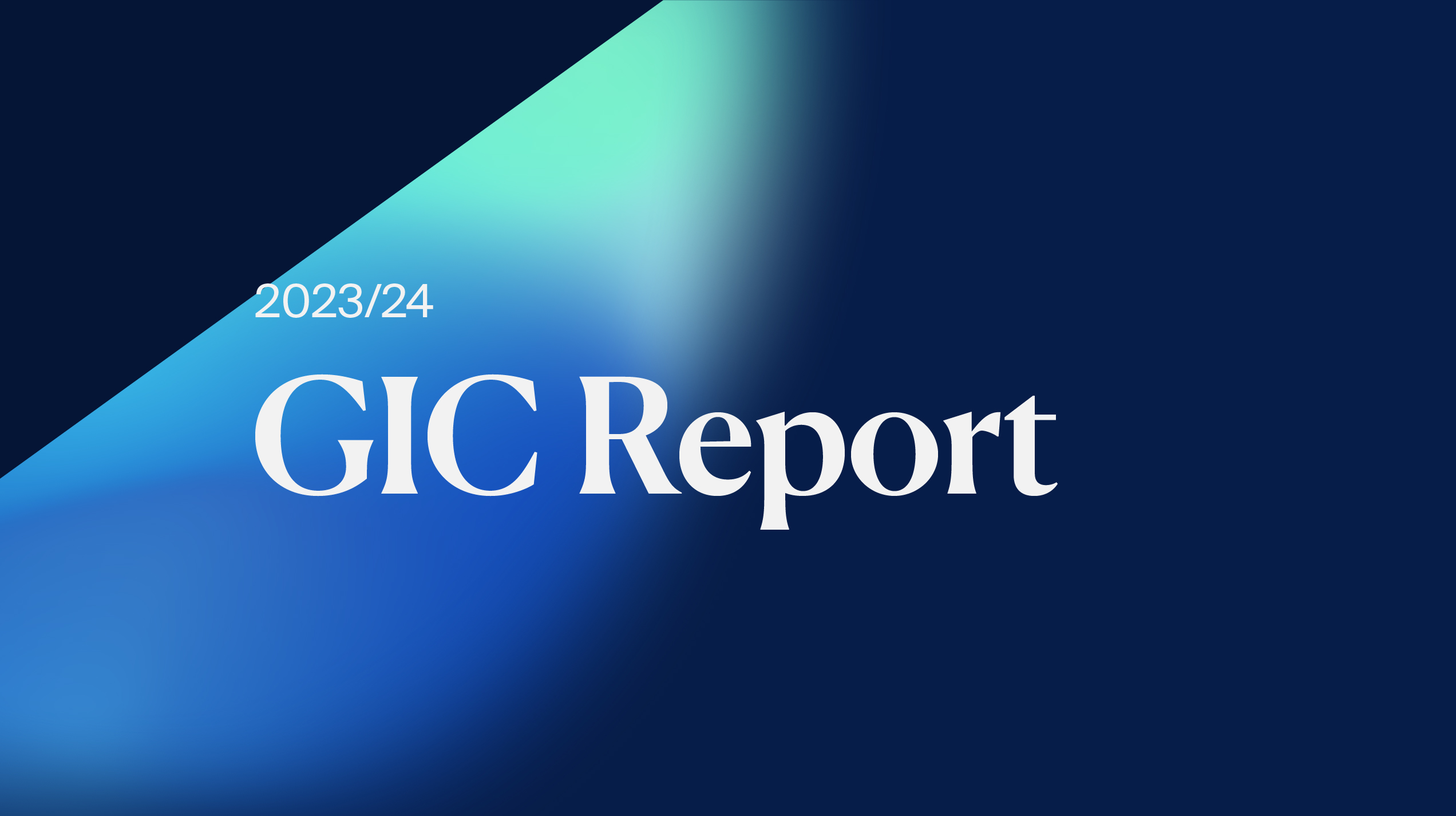This article is republished from the feature article titled “Infrastructure: A Resilient Strategy in Uncertain Times” in the GIC Report FY2022/23. You may read the full report here.
What is infrastructure?
GIC defines infrastructure as investments with a combination of stable and predictable cash flows, ability to pass through inflation, and low risk of obsolescence. These investments offer a unique proposition to the GIC portfolio. Their returns tend to be resilient across macroeconomic cycles due to the defensive nature of the underlying assets.
Infrastructure assets undergird economies and are essential for safe modern living. Quality infrastructure provides us with access to clean water and reliable electricity supply, as well as digital and physical connectivity. GIC’s infrastructure portfolio includes companies that develop and operate airports, seaports, electricity utilities, renewable energy generation, fiber networks, and telecommunication towers.
The range of infrastructure investments evolves with the emergence of new needs and technologies. This has generated healthy growth in investment opportunities for GIC.
First, existing infrastructure businesses require consistent, long-term investments to continue serving their communities effectively. Second, awareness and criticality of climate change and energy security have widened opportunities in energy transition. Third, digitalisation trends such as increased data consumption and cloud migration have been turbocharged by the Covid-19 pandemic and the advent of artificial intelligence, requiring increased digital infrastructure capacity.
Case study: GIC’s investments in digital infrastructure opportunities
In line with the world’s growing demand for data and bandwidth, the digital infrastructure sector has seen a marked increase in investments across various markets. Examples of investments by GIC:
Cellnex: Europe’s largest independent telecom tower company which signs long-term, inflation-indexed contracts with network operators and enables broad and fast connectivity to individual consumers and businesses. GIC first acquired a minority stake in Cellnex in 2018. Since then, we have supported its growth (both organic and inorganic) through additional financings, contributing to its more than five-fold growth to more than 147k tower sites today.
Cetin Group: This is the largest provider of network infrastructure in the Central and Eastern European (“CEE”) region. In 2021, GIC acquired a 30% stake in Cetin, which was established through carve outs of fixed and wireless telecommunication infrastructure assets of CEE mobile and broadband network operators. These operators continue to serve as Cetin’s key customers and provide stable revenues to Cetin via long-term contractual agreements.
Searchlight Fiber Alliance: In 2022, GIC invested in this fiber-to-the-home (“FTTH”) platform targeting suburban areas across the United States that lack access to high-speed broadband. Searchlight adopts a partnership-driven approach to lower build costs and accelerate build timelines via partnerships with electric utility companies and, where available, incorporates government incentives to ensure affordable services.
Infrastructure lies at the heart of these pursuits.
Global infrastructure investment needs are expected to total US$94tn between 2017 to 2040. This implies an average of US$3.9tn per annum.1
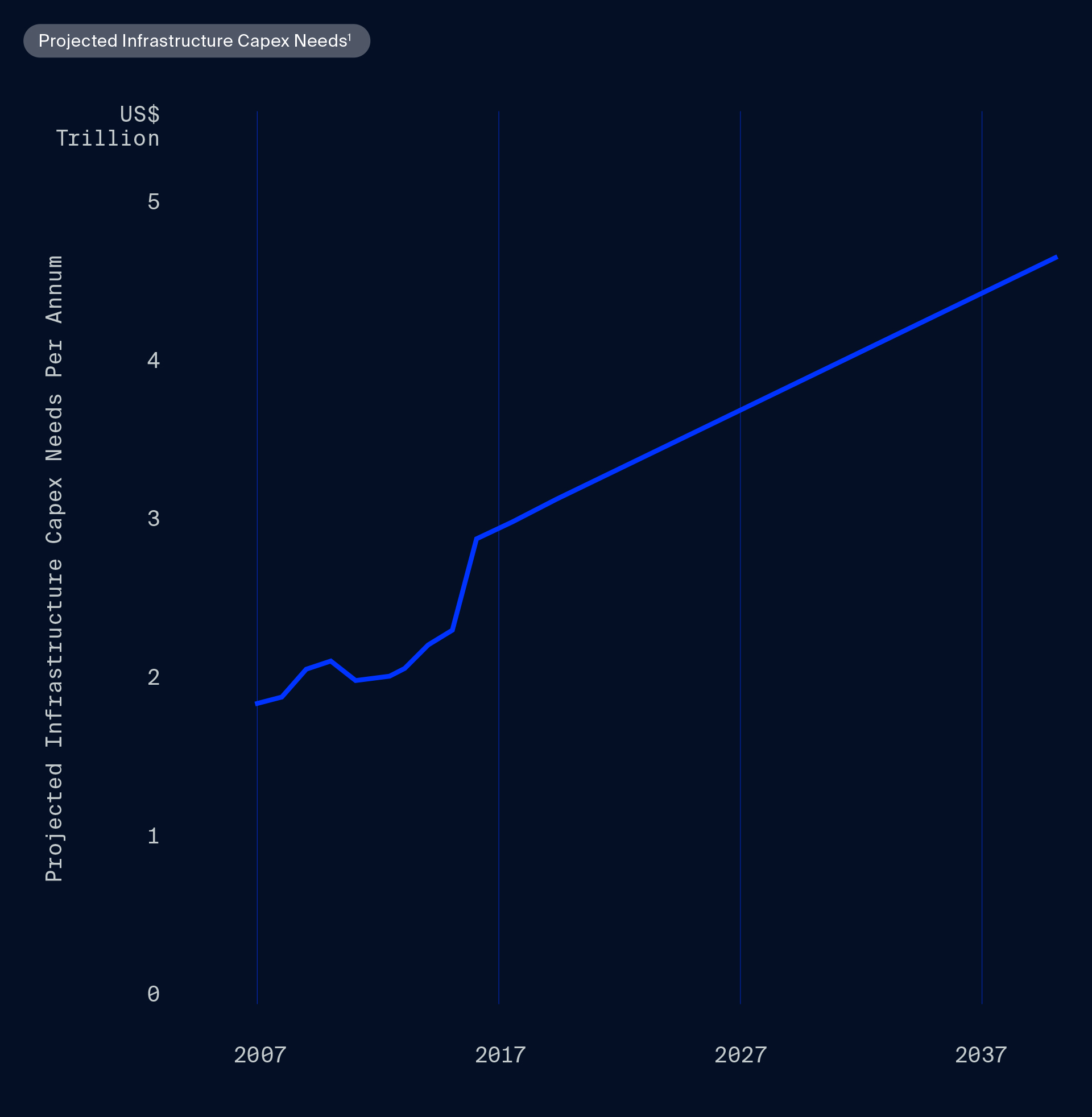
In an increasingly uncertain macroeconomic environment, it is unsurprising that infrastructure has become a popular asset class for large institutional investors and fund managers.
This has led to increased competition and higher entry prices for investors. The larger opportunity set has also widened the nature of risks. Regulatory risks have gone up in some jurisdictions, due to national security concerns and the need to mitigate inflationary pressures.
Infrastructure investors need to be attuned to the multitude of risks, account for the needs of a wide range of stakeholders, and invest mindfully.
The role of infrastructure investments: Resilience for the GIC portfolio
GIC typically invests in infrastructure businesses with high barriers to entry, regulated returns, and/or long-term contracted revenue models. Such businesses generate stable, predictable, and often inflation-protected cash flows across macroeconomic cycles. GIC also chooses businesses that can remain competitive in the long-term and have good potential for growth.
To date, our infrastructure investments have yielded healthy and stable returns for GIC’s total portfolio and support GIC’s long-term investment mandate. They also help to diversify the total GIC portfolio because of their low correlation with other asset classes.
Each infrastructure investment is assessed for five key characteristics that speak to the qualities of its business and underpins its investment thesis.
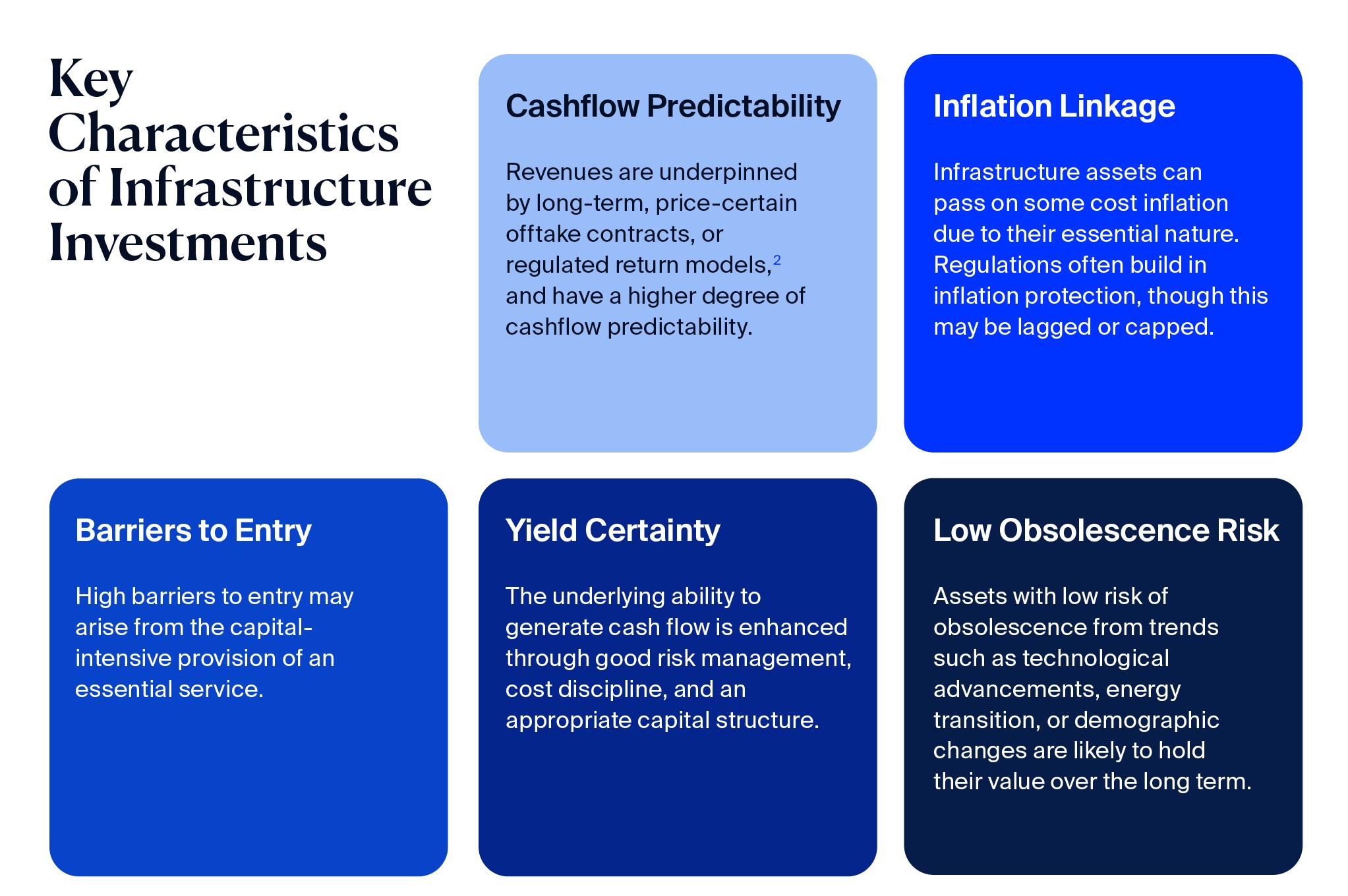
[2] A regulated market is one over which government or independent regulatory bodies exert a level of oversight and control. In the infrastructure space, the allowed financial returns of a regulated asset are periodically reviewed by the regulator according to transparent and reasonable measures of cost of capital.
Even as we ensure investee companies have cash generative assets today, our team maintains strong awareness of obsolescence risk. We constantly try to position ourselves early for opportunities in evolving sectors that mature and become less risky over time.
For instance, to prepare for the energy transition, GIC has made early investments in renewable energy companies, future fuels such as green hydrogen, long-term energy storage, and carbon capture and sequestration.
Case study: ACEN
ACEN is the renewable energy platform of the Ayala Group, one of the largest conglomerates in the Philippines and a long-time partner of GIC. In 2020, GIC invested in ACEN to help fund the development of its renewable energy project pipeline, enabling it to accelerate and expand its green investments across the Asia-Pacific region. Our investment has enabled ACEN to double its attributable operating and under-construction capacity to ~4GW in the Philippines, Australia, Vietnam, Indonesia, and India.
ACEN’s growth strategy is driven by a combination of home-grown development expertise as well as strategic partnerships with local and global renewable energy developers. While the Philippines remains its core market, its reputation as a strong partner has opened opportunities in developing countries with large renewable energy requirements, such as Vietnam. It recently built on this success by acquiring control of its Australian platform to participate fully in the country’s energy transition. ACEN’s investment programme in the coming years will further contribute to the significant renewable energy rollout required to reduce the Asia-Pacific region’s reliance on fossil fuels.
The resilience of GIC’s infrastructure portfolio is further enhanced by diversifying across regions and sectors.
Our developed market portfolio mainly comprises assets with mature, low-to-moderate risk, while our emerging markets portfolio includes investments with higher growth potential. GIC’s institutional familiarity with emerging markets has enabled us to be an early investor in its infrastructure sector. Relative to our peers, we have a sizeable infrastructure portfolio in emerging markets.
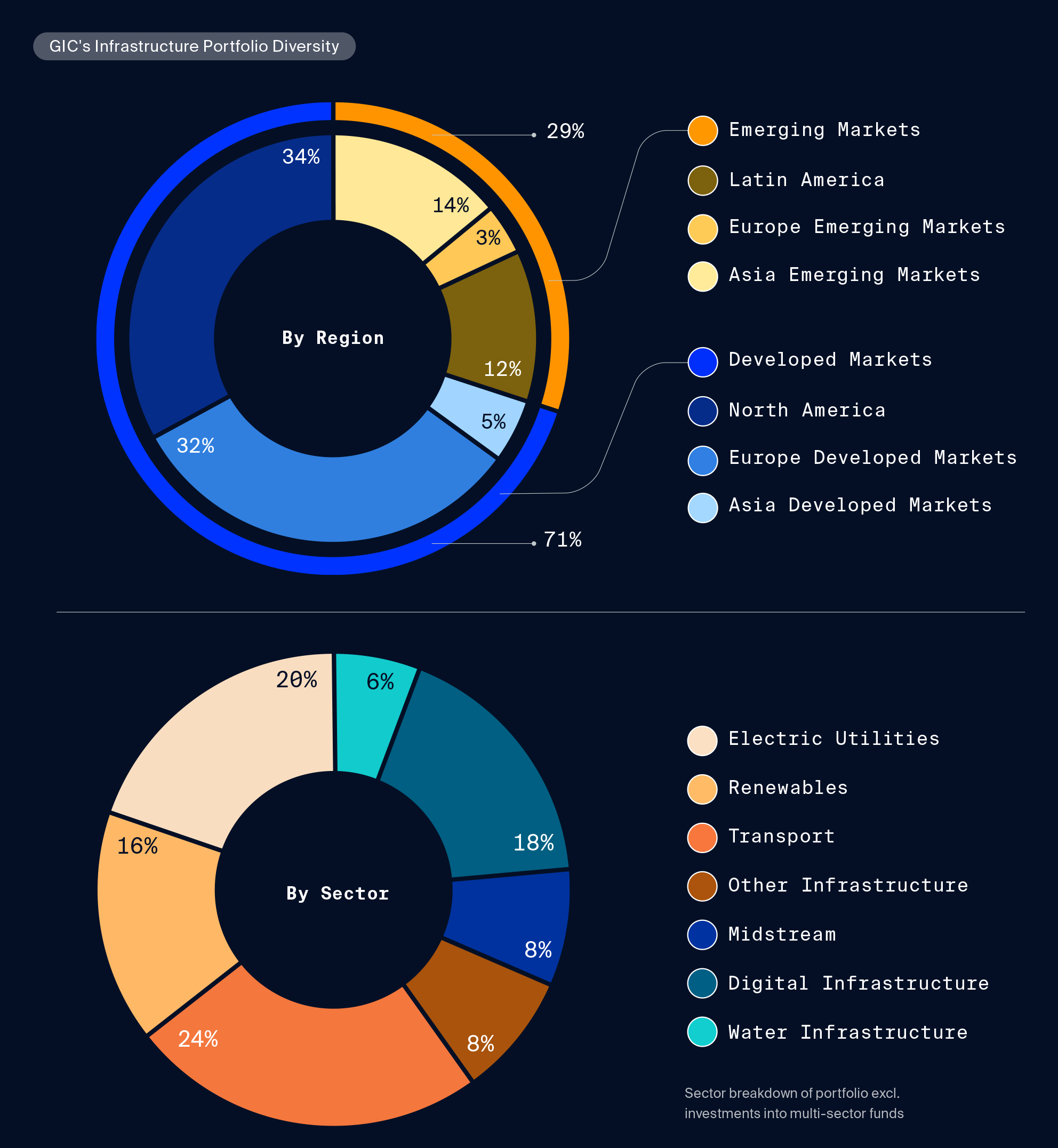
With a long-term investment orientation, our infrastructure investment team looks forward to working with businesses seeking good, sustainable growth.
Case study: Aegea
Aegea is a Brazilian water supply and sewage treatment company. GIC acquired a minority stake in Aegea in 2013. Since then, we have supported the company through multiple investment rounds and helped strengthen its governance, enabling Aegea to grow its customer base nearly 15 times, from 2 million to 31 million consumers. Today, it is the largest privately owned and one of the most efficient (measured by operational cost per customer) water companies in Brazil.
Aegea acquires municipal water companies and improves their operations, efficiency, and service levels, while investing the necessary capital expenditure to expand service coverage and reduce water leakage, most of the time without the need to raise tariffs (except for the allowed annual inflation adjustment). By expanding its service coverage, Aegea has improved the lives of millions who can now access clean water and benefit from proper sewage treatment – some for the first time in their lives, and at preferential rates for the lower-income. As part of its social program, Aegea has also hired thousands of workers from the vulnerable communities it serves.
In addition, by drastically reducing or eliminating the discharge of raw sewage into the river systems and seas, Aegea’s services have noticeably benefitted the environment and wellbeing of communities it serves. For example, in a state north of Rio de Janeiro, Aegea made investments to collect and treat the sewage in five cities around the Araruama Lagoon, preventing direct discharge of waste into the lagoon. After a few years the lagoon had become cleaner, with fishing activities resuming and tourism recovering. At the same time, hospital admissions related to water borne diseases decreased by 80%, public health expenditures reduced by 60%, and indicators such as infant mortality improved significantly.
GIC’s multi-pronged strategy for infrastructure investments
People are at the heart of GIC’s infrastructure investment approach and strategy.
Today, our infrastructure team comprises about 70 investment professionals operating out of four of GIC’s 11 global offices – Singapore, London, New York, and Sao Paolo.
The team executes a consistent, disciplined, and value-conscious investment approach. Oversight is provided through a Global Investment Committee to ensure prudence and consistency across investment execution and asset management. ESG values are integrated into the life cycle of GIC’s infrastructure investments, given the essential nature of the underlying businesses.
Underpinning GIC’s infrastructure approach is a Four-Quadrant investment strategy that allows the team to invest across multiple parts of the capital structure via different investment structures. The strategy comprises primarily direct investments in private or listed infrastructure businesses, either through equity or non-investment grade infrastructure credit. Select investments with well-regarded fund managers complement the direct investment portfolio.
By leveraging the Four-Quadrant strategy, GIC’s infrastructure team operates efficiently and flexibly to capture attractive risk-adjusted opportunities in the sector while maintaining a steady investment pace and portfolio growth through economic cycles.
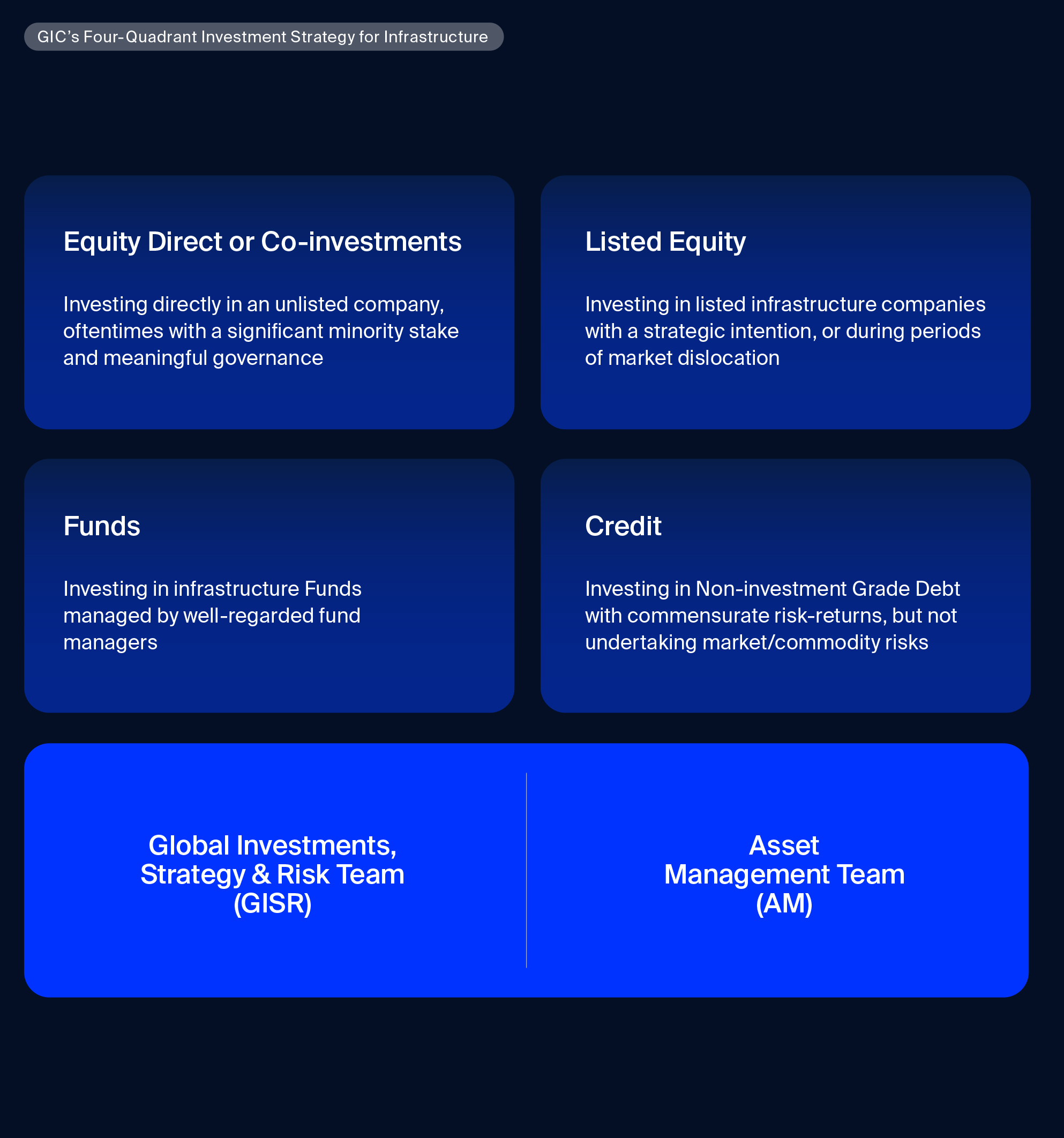
The Four-Quadrant investment strategy is supported by two specialist units – the Asset Management (AM) team and the Global Investments, Strategy, and Risk (GISR) team.
Our infrastructure investment team takes a hands-on value creation approach towards its investments. The AM team, led by senior executives with backgrounds in industry, ensures that investee companies are operating efficiently with good governance to achieve sustainable returns.
The GISR team complements the investment process through portfolio construction, risk monitoring, and individual deal reviews. It actively stays abreast of drivers such as climate change and technology disruption that pose both risks and opportunities to GIC’s infrastructure portfolio.
Doing more, doing well, and doing good
As the world moves towards a greener and more digitalised future, our infrastructure investments team will continue to use its expertise to access new opportunities. The asset class is an integral part of GIC’s diversified portfolio, contributing to sustainable, long-term, and inflation-protected returns for Singapore.
"Infrastructure enables essential services that undergird economies, connect communities, and ensure a good quality of life."
— Ang Eng Seng, CIO, Infrastructure, GIC
